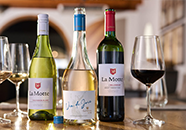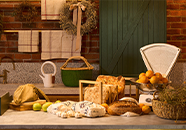
It is spring in the Winelands and in Pierneef à La Motte restaurant the beautiful colours and flavours of spring flowers are used creatively in an array of dishes. They add colour to your terrine and ballotine, some extra flavour and freshness to a salad or consommé and just that extra touch of joy to desserts.
And although nowadays we are delighted to see some pretty flowers on our plate, it is nothing new. During the Middle Ages, people often used flower in food and we can even see it in many paintings of that era.

Flowers and Food displayed in this painting by Josefa de Ayala (Josefa de Óbidos), Still-life, c. 1679, Santarém, Municipal Library
In his journals, Jan van Riebeeck also refers to the usage of borage flowers in salads for their taste and beauty. In those days edible cornflowers, borage flowers and the flowers of sage, rosemary and nasturtium were often harvested in the veld to be used in the kitchen.
Some flowers with distinctive flavours such as rose petals, violets and orange blossoms were used as extract to flavour pastries and baked goods as well as savoury dishes. They were also used as jellies and jams or were preserved in alcohol or salted water for later use.
Some of the most popular flowers used in South African food are waterblommetjies, artichokes and sour figs.

Waterblommetjies Picture source

Artichoke Picture source

Sour Fig Picture source
In general people are uneducated about which flowers are poisonous and therefore hesitant to use flowers in food, but with a little bit of knowledge it is easy to transform a dull plate into a sensory sensation. Remember that everything on the plate should be edible. For a list of edible flowers, use this handy chart.
In Pierneef à La Motte we often use Lemon Verbena for its minty and lemony flavour and Pansies for their beauty. Other spring favourites are pineapple sage, Nasturtium, broccoli flowers, rocket flowers, basil sprouts and sorrel flowers.

Pineapple sage (red flowers), Nasturtium (orange), broccoli (yellow), rocket (white) and sorrel (green).
In our cookbook, Cape Winelands Cuisine, sharing the history and recipes of the traditional food of the Cape Winelands, flowers are also used as decoration and ingredients.

Bacon Tart with chive flowers (page 25)

Pickled ox tongue with anchovy and caper sauce with purple sage flowers (age 133)

Melon soup with chopped mint and basil flowers (p 199)
Recipe for Melon soup with chopped mint and basil flowers
Serves: 6
Jan van Riebeeck planted the first melon at the Cape. In the Netherlands and later in the Cape, the fruit was served thinly sliced and eaten with salt and sand sometimes with pepper. As an interesting aside, the first melons harvested at the Cape were quite small and, in 1659, Jan van Riebeeck declared that a melon could be sold for a quarter penny if it was ripe and weighed at least a pound (450 g).
This recipe is an example of the sweet soups the seventeenth century.
Ingredients
1 sweet melon
7 Tbsp (105 ml) sweet dessert wine or sherry
2 sprigs fresh mint
1 cup (250 ml) fresh cream
1 cup (250 ml) finely diced fresh seasonal fruit
Chopped fresh mint, for garnishing
Method
Peel the melon and purée the flesh in a blender with the wine until smooth
Add the mint refrigerate overnight.
The following day, remove the mint and add the cream.
Scoop ¼ (60 ml) of the fresh diced fruit into a soup plate.
Pour the melon soup over and garnish with chopped mint.












